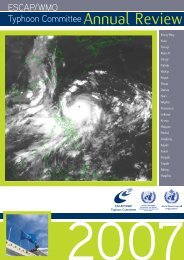TCAR - Typhoon Committee
TCAR - Typhoon Committee
TCAR - Typhoon Committee
Create successful ePaper yourself
Turn your PDF publications into a flip-book with our unique Google optimized e-Paper software.
80<br />
ESCAP/WMO<br />
<strong>Typhoon</strong> <strong>Committee</strong> Annual Review 2009<br />
adverse impact of disasters on the economic and<br />
social development of Member Countries. The<br />
ACDM continues to function as a significant platform<br />
to foster mutual support and assistance in disaster<br />
management among Member Countries through<br />
capacity building programs, coordination and<br />
multilateral cooperation. The ACDM also played<br />
an important role during the Cyclone Nargis event<br />
in Myanmar particularly in response and recovery<br />
activities conducted by the ASEAN Emergency<br />
Rapid Assessment Team (ERAT) and ASEAN<br />
Humanitarian Task Force (AHTF) for cyclone victims.<br />
In addition to the efforts taken above, Malaysia had<br />
also sent a Medical Team to Myanmar from 25<br />
June until 9 July 2008, comprising 25 experts<br />
from the Ministry of Health, the Malaysian Armed<br />
Forces and non-government organisations (NGOs).<br />
Prior to the deployment of the team, Malaysia has<br />
also sent relief items and medical supplies to the<br />
people of Myanmar. In regard to the disastrous<br />
<strong>Typhoon</strong>s Ketsana and Parma that struck parts of<br />
the Philippines on September and October 2009,<br />
Malaysia had already sent 42 tones of relief items<br />
on 16 October, 18 October and 19 October 2009<br />
to the Republic of Philippines.<br />
Malaysia has been tasked to lead the Sub-<br />
<strong>Committee</strong> for the development of ASEAN<br />
Standard Operating Procedure for Regional Standby<br />
Arrangements and Coordination of Joint Disaster<br />
Relief and Emergency Response Operations<br />
(SASOP) together with the Philippines, Thailand,<br />
Singapore and ASEAN Secretariat. During the 11th<br />
ACDM Meeting in Kota Kinabalu Sabah, Sections I to<br />
Section V of the ASEAN SASOP were adopted for<br />
implementation.<br />
2.4 Strengthened Resilience of Communities to<br />
<strong>Typhoon</strong>-related Disasters.<br />
2.4.1 Hydrological Achievements/Results<br />
Technical Advancement<br />
The InfoBanjir website (http://infobanjir.water.gov.<br />
my) continues to be enhanced and improved in<br />
terms of technology, hardware, procurement and<br />
network expansion as well as its contents to meet<br />
the customer’s requirement. It has recently included<br />
rainfall isohyet maps where users can monitor and<br />
assess the severity of rainfall of the previous<br />
events. It has also included the improvement of on-line<br />
flood reporting in order to expedite the dissemination<br />
of the flood reports to the top management.<br />
2.4.2 Disaster Prevention and Preparedness<br />
Achievements/Results<br />
National Disaster Relief Trust Fund (NDRF)<br />
The Government has established the National Disaster<br />
Relief Fund to provide financial assistance to<br />
disaster victims. Building on the experience of the<br />
widespread monsoon flood in 2006, the Government<br />
through the Central Bank of Malaysia has allocated<br />
RM500 million worth of special relief guarantee<br />
facility (SRGF) to be administered by all commercial<br />
banks, Bank Perusahaan Kecil & Sederhana Malaysia<br />
Berhad, Bank Kerjasama Rakyat Malaysia Berhad<br />
and Bank Pertanian Malaysia aimed at recovering<br />
businesses and rebuilding damaged infrastructure<br />
in areas affected by disasters.<br />
The response to the facility was very encouraging<br />
with 4,641 applications being approved, amounting<br />
to approximately RM472 million. This facility is an<br />
example of public-private-partnership in which the<br />
commercial banks provide the financing with 2.5%<br />
interest to the borrower whilst the Central Bank<br />
covers an additional 2.45% of interest and 80%<br />
guarantee of the financing obtained.<br />
Cooperative Establishment<br />
The establishment of a cooperative in the form<br />
of Amanah Ikhtiar Malaysia (The Endeavor Trust<br />
of Malaysia) in 1987 has improved the resilience<br />
of communities previously vulnerable to disasters.<br />
Currently, Amanah Ikhtiar Malaysia provides<br />
service to more than 180,000 families in Malaysia.<br />
Services provided include micro financing,<br />
compulsory savings and welfare funds for the poor<br />
and marginalized.<br />
2.4.3 Research, Training, and Other<br />
Achievements/Results Enhancement of Public<br />
Education and Awareness<br />
To instill disaster risk reduction awareness among<br />
the public, various initiatives were introduced.<br />
These include awareness programs for disasters<br />
such as landslides, tsunami, and floods by the Public<br />
Works Department, the Malaysian Meteorological<br />
Department, the Ministry of Education and National<br />
University of Malaysia under the Southeast Asia<br />
Disaster Prevention Institute.<br />
Several programs have been implemented to improve<br />
the resilience of schools and hospitals against<br />
disasters. The Ministry of Education in collaboration<br />
with civil societies and UNICEF has put forward<br />
initiatives such as the School Watching Program and<br />
SMART Support Team in schools. The Ministry of<br />
Health celebrated National Health Day by adopting

















